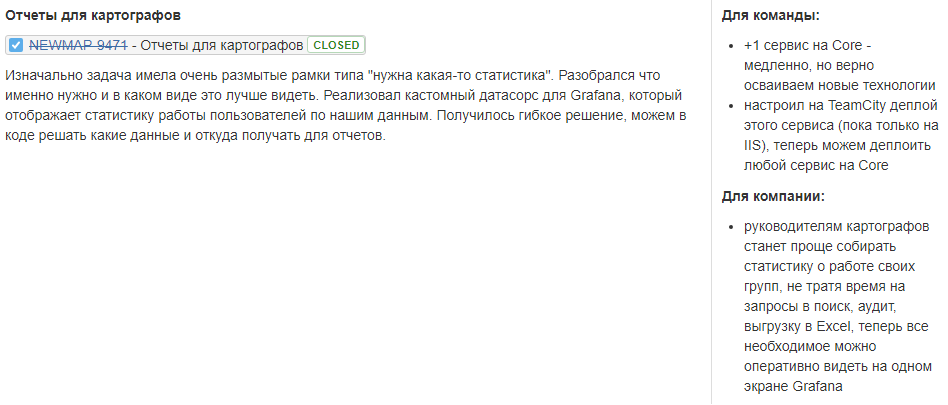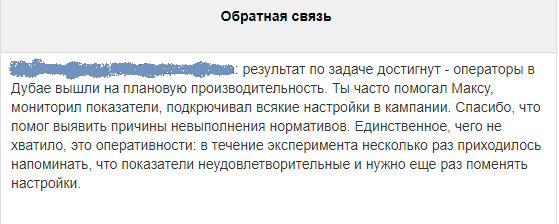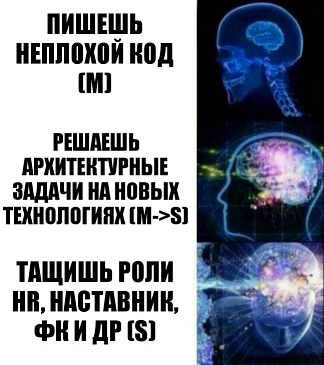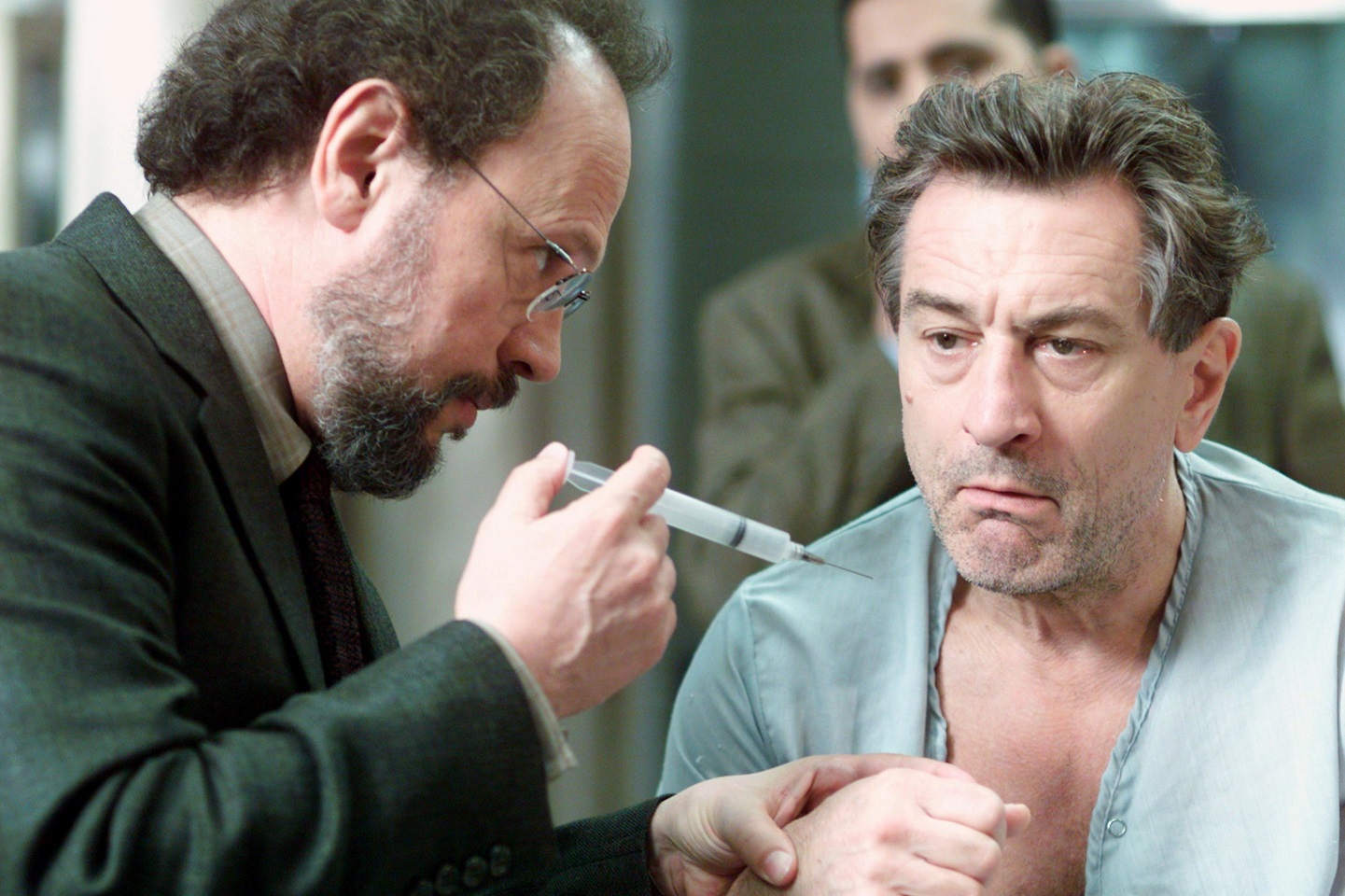Three years of certification without managers - normal flight

Our unit has been working without managers since the end of 2015. We decide for ourselves who and how much to pay, who worked well and who did not really, whom to hire, and with whom to leave. In the article I will tell about the most difficult thing - working with people. I will share with you how our engineers certify engineers, who now does all the useful work that the managers did and, of course, how many people had to be fired in order to implement it all.
Prehistory
I am responsible for the work of one of the development divisions in 2GIS - we are 36 people, 4 teams. We develop software for the internal needs of the company, our users are contact center operators, GIS specialists, employees who verify information about organizations on the ground, and other great people.
At the end of 2015, we decided to move from the matrix form of organization of management to the form in which there are no managers. On the one hand, we were inspired by the ideas of Frederick Lahl, presented in his book “Discovering the Future Organizations”, and on the other, we had our own, very specific reasons.
Three key ideas of turquoise organizations
Бирюзовые организации эффективно решают задачи любого уровня сложности, используя систему, основанную на взаимодействии равноправных коллег. При работе в этой системе нет нужды ни в иерархии, ни в консенсусе.
Традиционно организации всегда поощряли сотрудников только за узкопрофессиональные качества, а остальные, личностные черты — предлагали оставлять за дверью. От нас требуют демонстрировать мужественную решимость, уверенность в себе и силу, а сомнения и слабости — скрывать. Рационализм царствует. Эмоции, интуиция и выражение духовных потребностей нежелательны и неуместны. В «бирюзовых организациях», напротив, разработан набор согласованных практик, побуждающих заново обратиться к нашей внутренней целостности и быть на работе тем, кто мы есть на самом деле.
Считается, что «бирюзовые организации» живут собственной жизнью и обладают собственным представлением о направлении дальнейшей деятельности. Членов организации побуждают не стараться предвидеть изменения и контролировать будущее, а вслушаться и понять, чем хочет стать организация, какой цели ей хочется служить.
Самоуправление
Бирюзовые организации эффективно решают задачи любого уровня сложности, используя систему, основанную на взаимодействии равноправных коллег. При работе в этой системе нет нужды ни в иерархии, ни в консенсусе.
Целостность
Традиционно организации всегда поощряли сотрудников только за узкопрофессиональные качества, а остальные, личностные черты — предлагали оставлять за дверью. От нас требуют демонстрировать мужественную решимость, уверенность в себе и силу, а сомнения и слабости — скрывать. Рационализм царствует. Эмоции, интуиция и выражение духовных потребностей нежелательны и неуместны. В «бирюзовых организациях», напротив, разработан набор согласованных практик, побуждающих заново обратиться к нашей внутренней целостности и быть на работе тем, кто мы есть на самом деле.
Эволюционная цель
Считается, что «бирюзовые организации» живут собственной жизнью и обладают собственным представлением о направлении дальнейшей деятельности. Членов организации побуждают не стараться предвидеть изменения и контролировать будущее, а вслушаться и понять, чем хочет стать организация, какой цели ей хочется служить.
The first reason was the difficulties faced by the current leaders. This was especially noticeable in the process of appraisal of employees. For example, difficulties arose for those managers who wanted to write code more, and not to bother with people. Another example is the line manager and the difficulties that he encountered in certification, when it was necessary to make decisions on people whom he knew only from someone else's words, did not sit with them in a team and especially did not overlap in tasks.
There was a second reason - at the end of 2015, we got together with the very leaders and thought about how we would like to see our service ideally. It turned out several different directions. And self-management turned out to be one of them - we wanted more employees to take part in making various kinds of decisions, to make these decisions faster, to have more initiatives.
Where are the leaders?

During the transition to work without managers, we, of course, understood that the mere presence of managers is not an absolute evil that needs to be eradicated. A good leader is a blessing both for the company and for subordinates. In our case, this benefit is a balanced combination of different roles - engineer, manager, mentor, expert in the product.
In fact, we have these roles now live separately, and not concentrated in one person. They can drag any engineer. For example, the developer or tester may be responsible for planning in a team. Plus, we try to ensure that these roles are not stuck for a long time in one person. This allows him not to fade, and others - to bring something new into our processes and products. Now we use the following roles - extreme for planning, retrospectives and meetings at the level of teams, feature-extreme and HR.
Of course, we didn’t fire the executives - they had the opportunity to focus on what they liked and did best.
Engineer in the role of HR

We use the term HR, but we mean by it not quite what is commonly accepted. What does an engineer do who has taken on the role of eychara for some of his colleagues? The main thing is that he builds trust with those for whom he acts in this role. Based on this trust, HRC monitors what the employee is sad and what pleases. Including tasks and salary. Individual topics - how comfortable it is for an employee to interact with other guys and his plans for cooperation with the company. Watching all this Eychar can at least in two ways - regular tete-a-tetami or just observation in the process. All this works especially well when HR is on the same team with those for whom he plays this role.
Why do you need it?
All the information received from people makes it possible to identify common motivators / demotivators at the subdivision level and, accordingly, strengthen / soften them. To hire new employees in advance, try to mapping people into tasks that they like, solve conflicts in a team and control undesired routine.
How did we find Eychar?
We began by going to look for guys who would like to try themselves in this role. We interviewed all our employees. We were lucky - there were such people. We went further and asked everyone the question: “And with whom would you be (a) ready (a) to confidentially discuss your work?”. We were lucky the second time. It turned out a good mapping - every employee has a Eychar, which he chose himself, and this Eychar wants to engage in this activity. Unfortunately, not in all cases it turned out that Eychar was sitting with the employee in the same office.
How do eychary work?
We have a tete-a-teta with the guys at least once every three months. The meeting takes about one hour. In general, the number of meetings and the volume of communication is the business of Eychara and the employee, for whom he plays this role.
At such meetings, Eychar asks open-ended questions, listens and clarifies. We practice the questions implied in the response assessment and explanation, such as "Rate on a scale how much you are interesting task, which you do?" And "What is missing to 5?"
After meeting all eychary gather and discuss issues that require a common attention. For example, general demotivators and how we want to soften / eliminate them. It happens that eychary are going to help each other in solving complex cases.
In addition to holding tete-a-tetov, Eychary work in this role in the background every day, looking after their colleagues. It is important to understand that Eychar is not the head of the employee and, therefore, cannot influence him with the help of additional powers. For example, assigning interesting tasks to a person and removing dull ones. Eychar with us - this is the one who helps the employee to get out himself, and does not take him out on himself.
For example, in interpersonal conflicts, Eychara’s task is to help the employee in such a way that he himself could kill the difficulties in communication. This help can be built around a joint response to questions like: “How best to give a colleague a friend to be heard?”, “But do I hear / understand his position?”. Of course, there are situations when the employee himself “does not take out”, but the priority is still the “do it yourself, and we are ready to provide you with all the necessary resources.”
And, of course, Eychary are important participants in the process of certification of employees, because they have important information about people. For example, they can help with the validation of wage decisions.
Now for our team of 36 people "eyeing" five Eycharov. Our distribution is not very even, and this is what we would like to improve - we are striving for a ratio of 1: 7.
Certification

We certify employees twice a year - in spring and autumn. At certification, we evaluate the results of employees, exchange feedback, make decisions related to salary changes. In a sense, we can say that certification is the process of evaluating the implementation of the contract between the employee and the company and making the decision to extend this contract on updated conditions.
Our certification consists of 5 stages:
1. Tet-a-thets
2. Self-assessment and feedback
3. Evaluation by colleagues
4. Salary change
5. Feedback in teams
Stage 1. Tet-a-Tety
In fact, this is not exactly the stage of certification, but the information from the attestation attestation is used. Let me remind you that we hold these tet-a-tetes at least 4 times a year and, accordingly, we have quite relevant information obtained with their help for each certification. This information includes the following: motivators / demotivators, satisfaction with tasks and salary, plans for further cooperation, expectations for changing salaries, and information about difficulties in communication with colleagues.
Stage 2. Self-esteem and feedback
At this stage, the employee independently evaluates his results for the past period since the last certification and publishes this information in the form of a page in confluence. On the page in the form of a table is a list of what the employee considers his results for the past period. We have no restrictions on what to write and what is not - this is entirely the position of the employee. That considers it necessary, then he writes. These may be product results in combat or something that is still far from production, but already seems significant. These can be process improvements or a well-executed role. Here the employee publishes his vision of what value his work has brought - for the company, the team, the product, the employee himself.
According to the main results, the employee needs to collect feedback from colleagues, customers, suppliers of all who can provide it. We try not to overwhelm each other with requests for the whole team, but to get along with the minimum composition. It is not necessary to collect the OS for all the results - usually 3-5 is enough.
Sample results

Feedback example

There are a couple of questions that need to be answered in general for the period - what are you proud of / what was great, what is sad / what did not succeed?
Plus, there is a section with general feedback, where anyone can nafidbachit employee for the past period as a whole, and not on a specific result.
At the end of this stage, the employee needs to measure the value of his results for the period in total. The value of the results is the basic qualification shown in the results, plus something else. This “something else” can be the result of a different specialization (for example, if the developer has done a great analytical task coolly) or is some kind of achievement related to processes.
The scale in which the value of the results is measured is the same as in the qualification graduation: intern, jun, jun +, middle and further. We use the following notation: -> J, J, J-> M, M, M-> S, S, S->.
Example of self-assessment:

At this stage in general, we assign a calendar week. That it was possible to work out and certification, and work tasks to do.
Stage 3. Evaluation by colleagues
The purpose of this stage is to increase the objectivity of the assessment of the value of the results of employees. We are going to the “expert” group, which includes representatives from each team and Eychary. In fact, we briefly discuss the page with the results, plus we look at the self-assessment and explanation of it. If necessary, we discuss something and clarify it with the representatives of the relevant team or with the employee Eychara.
Self-assessment and evaluation of "experts" do not always coincide. During the certification in September 2018, six employees, according to the “experts”, underestimated their activities, and four overestimated them. In all these cases, an HR manager at a meeting with an employee explains why the group gave such an assessment.
This stage also takes about one calendar week. The expert meeting itself took us 2 hours * 9 people in September 2018 to make decisions on 36 employees.
Stage 4. Salary change

At the start of certification, our real HR (not the one that the Eichary engineers) provide us with information about the salary market in our city. We adapt this information to our scale: -> J, J, J-> M, M, M-> S, S, S->. By adapting this information, we focus on the range between the median and the top quartile.
The formula that we use as the first step in determining wages:

The market is the salary from market research, corresponding to the value of the employee’s results for the past period.
Since the growth dynamics of the unit’s salary is limited within each assessment, we use the F function, which cram all our decisions into this constraint. In fact, it proportionately cuts them - in case we do not satisfy the constraint.
After that, our HR managers validate the decisions for those employees for whom they are responsible. And it is precisely here that their knowledge about people obtained at tete-a-tetah is necessary. We resort to manual adjustments in exceptional cases. We strive to ensure that two employees with the same value of results receive an equally good salary.
The received solutions are sent to the mail of each employee, along with a questionnaire about how much the employee is satisfied with this decision. With those who are not satisfied with the changes in salary, we are talking and trying to understand whether we are mistaken. Errors are corrected.
Here is the picture from the last certification:

Stage 5. OS Exchange Meetings in Teams

At this stage, we hold meetings within the teams to exchange live feedback. It’s easier to hear your colleagues than during correspondence. Therefore, there is a lot of feedback about development and about what could be done better. The format of the meeting is quite simple - everyone wants to speak for each employee, answering, in fact, one question: “What do you want to say to a colleague on the basis of the past period and wish for the future?”
After everyone has spoken, the word is given to the person who received feedback so he can say the answer word. I take part in all these meetings, and for me this is a unique opportunity to hear live feedback from each employee of my unit. Usually such meetings take 2-4 hours per team.
At this stage, certification ends. In September 2018, it took us 3 calendar weeks. At the end of each appraisal, we request feedback from process staff. Here is a part of it from the last appraisal:

What happens to those who are demotivated after certification?

After certification, it happens that some of the guys are demotivated: for example, he believed that he worked coolly, and his results were assessed moderately. It is clear that just to close your eyes to this and live on is not good. Such situations are work for our eychars. Their task is to help the employee to understand what was not very good and what should be done differently in order to achieve the best results for the next certification. Of course, all this is possible only if the employee himself wants to change and improve something.
What do we like?
In our certification, we are pleased with a sufficiently high transparency of what is happening for all participants - almost all the information is open. It is also good that we focus on the value of the results - on the manifested qualifications, and not on its potential. I am glad that we manage to provide a decent level of feedback for employees.
What do we want to improve?
Of course, the process is not perfect, and each time we try to improve it, relying on feedback from employees. For example, next time we want to work on improving the quality of the results of the self-assessment stage: some guys have difficulties with preparing a page with the results and collecting feedback. There is something to improve in the work of the expert group - this concerns those facilitation techniques that we use at the meeting.
What do I think about this, as the extreme for the unit?
What we finally got with certification is, in my opinion, better than our story with the leaders of the 2015 sample, who did not want to do this and / or did not have a trusting relationship with their subordinates. And, of course, the point here is not the word “leader”, but the words “want” and “trust”. I like the approach in which we are not trying to find one person (leader) who can take out several roles abruptly, and the mappim have these roles for different people, trying to use the principle “I want” and not to forget about rotation.
PS If you are interested in this story, see the story of my colleague Alexander Kartavtsev this year about the featured ones .
